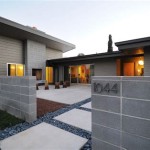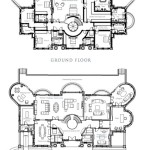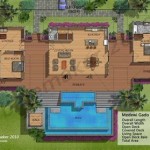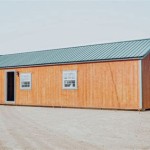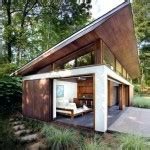Mid-Century Modern style house plans embody the architectural movement that emerged in the middle of the 20th century, characterized by clean lines, open floor plans, and an emphasis on indoor-outdoor living. These plans were popularized by architects such as Frank Lloyd Wright, Ludwig Mies van der Rohe, and Charles Eames, and can be found in many residential neighborhoods built during the 1950s and 1960s.
Mid-Century Modern homes often feature distinctive features such as large windows, sliding glass doors, and exposed beams. They are designed to be energy-efficient and to take advantage of natural light. The open floor plans allow for easy flow between indoor and outdoor spaces, creating a sense of spaciousness and inviting the outdoors in.
In this article, we will explore the key characteristics of Mid-Century Modern style house plans, discuss their history and evolution, and provide tips for incorporating this style into your own home.
Mid-Century Modern style house plans are characterized by several key features, including:
- Clean lines
- Open floor plans
- Indoor-outdoor living
- Large windows
- Sliding glass doors
- Exposed beams
- Energy efficiency
- Natural light
- Emphasis on functionality
- Integration of indoor and outdoor spaces
These features combine to create homes that are both stylish and functional, with a timeless appeal that continues to be popular today.
Clean lines
One of the most distinctive features of Mid-Century Modern style house plans is their emphasis on clean lines. This means that the homes are designed with simple, geometric shapes, and avoid unnecessary ornamentation or clutter.
- Horizontal lines
Horizontal lines are a key element of Mid-Century Modern design. They can be found in the rooflines, windows, and even the furniture. Horizontal lines create a sense of balance and calm, and they help to visually widen the space.
- Vertical lines
Vertical lines are also used to create a sense of balance and proportion in Mid-Century Modern homes. They can be found in the columns, beams, and windows. Vertical lines help to draw the eye upward, and they can make the space feel taller.
- Clean edges
Mid-Century Modern homes typically have clean edges, with no unnecessary curves or frills. This creates a sense of order and simplicity, and it helps to highlight the home’s geometric shapes.
- Minimalist details
Mid-Century Modern homes are known for their minimalist details. This means that there is no unnecessary ornamentation or clutter. The focus is on the clean lines and simple forms of the home itself.
The use of clean lines in Mid-Century Modern style house plans creates a sense of order, balance, and simplicity. These homes are designed to be both stylish and functional, with a timeless appeal that continues to be popular today.
Open floor plans
One of the defining characteristics of Mid-Century Modern style house plans is their open floor plans. This means that the traditional walls between the living room, dining room, and kitchen are removed, creating one large, open space. This type of floor plan allows for a more fluid and flexible use of space, and it helps to create a sense of spaciousness and light.
Open floor plans are also ideal for entertaining, as they allow guests to move easily between different areas of the home. They can also be more family-friendly, as they allow parents to keep an eye on their children while they are playing or doing other activities.
There are a few things to keep in mind when designing an open floor plan. First, it is important to define the different areas of the space, even if there are no physical walls separating them. This can be done using furniture, rugs, or changes in flooring. Second, it is important to ensure that there is adequate natural light throughout the space. This can be achieved by using large windows and skylights.
Open floor plans can be a great way to create a more modern and inviting home. They are perfect for entertaining, and they can also be more family-friendly. When designing an open floor plan, it is important to keep in mind the need to define the different areas of the space and to ensure that there is adequate natural light.
If you are considering building a new home, or renovating your existing home, an open floor plan is a great option to consider. It can help you to create a more modern, spacious, and inviting home that is perfect for entertaining and family life.
Indoor-outdoor living
Indoor-outdoor living is a key feature of Mid-Century Modern style house plans. This means that the homes are designed to take advantage of the natural surroundings, and to create a seamless transition between the indoors and outdoors.
There are a number of ways to achieve indoor-outdoor living in a Mid-Century Modern home. One common approach is to use large windows and sliding glass doors. This allows for natural light to flood into the home, and it also makes it easy to open up the home to the outdoors.
Another way to achieve indoor-outdoor living is to use patios, decks, and courtyards. These outdoor spaces can be used for entertaining, dining, or simply relaxing. They can also be used to extend the living space of the home, and to create a more seamless transition between the indoors and outdoors.
Indoor-outdoor living is a great way to enjoy the natural surroundings, and to create a more inviting and comfortable home. It is a key feature of Mid-Century Modern style house plans, and it is a trend that continues to be popular today.
If you are considering building a new home, or renovating your existing home, there are a number of ways to incorporate indoor-outdoor living into your design. By using large windows and sliding glass doors, and by creating outdoor spaces such as patios, decks, and courtyards, you can create a home that is both stylish and functional, and that takes advantage of the natural surroundings.
Large windows
Large windows are a key feature of Mid-Century Modern style house plans. They allow for natural light to flood into the home, and they also make it easy to open up the home to the outdoors. This creates a sense of spaciousness and light, and it helps to blur the lines between the indoors and outdoors.
There are a number of different types of large windows that can be used in Mid-Century Modern homes. Some of the most popular types include:
- Picture windows: Picture windows are large, fixed windows that offer a panoramic view of the outdoors. They are often used in living rooms and dining rooms, and they can help to create a sense of spaciousness and light.
- Sliding glass doors: Sliding glass doors are another popular type of large window used in Mid-Century Modern homes. They allow for easy access to the outdoors, and they can be used to create a seamless transition between the indoors and outdoors.
- Casement windows: Casement windows are hinged windows that open outward. They are often used in bedrooms and bathrooms, and they can provide good ventilation and natural light.
When choosing large windows for your Mid-Century Modern home, it is important to consider the following factors:
- Size and placement: The size and placement of your windows will depend on the size and layout of your home, as well as your personal preferences. It is important to choose windows that are large enough to allow for plenty of natural light, but not so large that they overwhelm the space.
- Type of window: There are a variety of different types of large windows available, so it is important to choose the type that best suits your needs. Consider the function of the room, the amount of ventilation you need, and the overall style of your home.
- Energy efficiency: When choosing large windows, it is important to consider their energy efficiency. Look for windows that are Energy Star certified, and that have a low U-factor and Solar Heat Gain Coefficient (SHGC).
Large windows are a great way to add style and functionality to your Mid-Century Modern home. They can help to create a sense of spaciousness and light, and they can also help to blur the lines between the indoors and outdoors. When choosing large windows for your home, be sure to consider the size, placement, type, and energy efficiency of the windows.
Sliding glass doors
Sliding glass doors are a key feature of Mid-Century Modern style house plans. They allow for easy access to the outdoors, and they can be used to create a seamless transition between the indoors and outdoors.
- Unobstructed views
Sliding glass doors offer unobstructed views of the outdoors. This can help to create a sense of spaciousness and light, and it can also help to bring the outdoors in. Sliding glass doors are a great way to enjoy the natural surroundings, and to create a more inviting and comfortable home.
- Easy access to the outdoors
Sliding glass doors make it easy to access the outdoors. This is ideal for entertaining, as it allows guests to easily move between the indoors and outdoors. Sliding glass doors are also great for families with children, as they allow children to easily play outside while still being supervised by their parents.
- Natural light
Sliding glass doors allow for plenty of natural light to enter the home. This can help to reduce the need for artificial lighting, and it can also help to create a more cheerful and inviting atmosphere. Natural light has also been shown to have a number of health benefits, including improved mood, increased productivity, and better sleep.
- Ventilation
Sliding glass doors can be opened to allow for ventilation. This is important for maintaining a healthy indoor air quality. Ventilation can help to remove pollutants, such as dust, pollen, and pet dander, from the air. It can also help to reduce the risk of respiratory problems, such as asthma and allergies.
Sliding glass doors are a great way to add style and functionality to your Mid-Century Modern home. They can help to create a sense of spaciousness and light, and they can also help to blur the lines between the indoors and outdoors. When choosing sliding glass doors for your home, be sure to consider the size, placement, and energy efficiency of the doors.
Exposed beams
Exposed beams are another key feature of Mid-Century Modern style house plans. Beams are typically made of wood, and they are used to support the roof of the house. In Mid-Century Modern homes, beams are often left exposed, creating a sense of warmth and rustic charm.
There are a number of different types of exposed beams that can be used in Mid-Century Modern homes. Some of the most popular types include:
- Ceiling beams: Ceiling beams are the most common type of exposed beam. They are typically made of wood, and they run across the ceiling of the room. Ceiling beams can help to create a sense of warmth and intimacy, and they can also add a touch of rustic charm.
- Rafter beams: Rafter beams are another type of exposed beam. They are typically made of wood, and they run from the roof of the house down to the walls. Rafter beams can help to create a sense of height and drama, and they can also add a touch of industrial charm.
- Truss beams: Truss beams are a type of exposed beam that is made of metal. They are typically used in larger homes, and they can help to create a sense of openness and space. Truss beams can also add a touch of modern industrial charm.
When choosing exposed beams for your Mid-Century Modern home, it is important to consider the following factors:
- Size and placement: The size and placement of your exposed beams will depend on the size and layout of your home, as well as your personal preferences. It is important to choose beams that are the right size for the space, and that are placed in a way that complements the overall design of the home.
- Type of beam: There are a variety of different types of exposed beams available, so it is important to choose the type that best suits your needs. Consider the function of the room, the overall style of your home, and the amount of natural light you want to allow into the space.
- Material: Exposed beams can be made from a variety of materials, including wood, metal, and concrete. It is important to choose a material that is durable and that will complement the overall style of your home.
Exposed beams are a great way to add style and character to your Mid-Century Modern home. They can help to create a sense of warmth, intimacy, height, and drama. When choosing exposed beams for your home, be sure to consider the size, placement, type, and material of the beams.
Energy efficiency
Mid-Century Modern style house plans are known for their energy efficiency. This is due to a number of factors, including the use of passive solar design, natural ventilation, and high-performance building materials.
Passive solar design is a way of designing buildings to take advantage of the sun’s energy for heating and cooling. This is done by orienting the building to face south, and by using large windows to allow sunlight to enter the home. The sunlight is then absorbed by the thermal mass of the building, which helps to regulate the temperature inside the home.
Natural ventilation is another important factor in the energy efficiency of Mid-Century Modern homes. This is achieved by using operable windows and doors to allow air to flow through the home. This helps to keep the home cool in the summer and warm in the winter.
High-performance building materials are also used in Mid-Century Modern homes to improve energy efficiency. These materials include insulation, windows, and doors that are designed to reduce heat loss and gain. By using these materials, Mid-Century Modern homes are able to maintain a comfortable temperature inside the home, while using less energy.
The energy efficiency of Mid-Century Modern style house plans is one of the reasons why they are so popular today. These homes are comfortable, affordable to operate, and they help to reduce our impact on the environment.
Natural light
Natural light is an important element of Mid-Century Modern style house plans. This is because natural light can help to create a sense of spaciousness, warmth, and well-being. It can also help to reduce the need for artificial lighting, which can save energy and money.
- Large windows
One of the most important ways to incorporate natural light into a Mid-Century Modern home is to use large windows. Large windows allow for plenty of natural light to enter the home, and they can also help to create a sense of spaciousness. When choosing windows for your Mid-Century Modern home, be sure to choose windows that are large enough to allow for plenty of natural light, but not so large that they overwhelm the space.
- Skylights
Skylights are another great way to incorporate natural light into a Mid-Century Modern home. Skylights are windows that are installed in the ceiling of a home. They allow for natural light to enter the home from above, which can help to create a sense of height and drama. Skylights are a great option for homes that have limited wall space for windows.
- Clerestory windows
Clerestory windows are a type of window that is installed high on the wall of a home. They allow for natural light to enter the home from above, but they do not provide a view to the outside. Clerestory windows are a great option for homes that need privacy, or for homes that are located in areas with harsh sunlight.
- Transom windows
Transom windows are a type of window that is installed above a door or window. They allow for natural light to enter the home, but they do not provide a view to the outside. Transom windows are a great option for homes that need privacy, or for homes that are located in areas with harsh sunlight.
By using natural light, Mid-Century Modern style house plans can create a sense of spaciousness, warmth, and well-being. Natural light can also help to reduce the need for artificial lighting, which can save energy and money.
Emphasis on functionality
Mid-Century Modern style house plans emphasize functionality. This means that the homes are designed to be comfortable, efficient, and easy to live in. This is achieved through a number of design features, including open floor plans, built-in storage, and multi-purpose spaces.
Open floor plans are a key feature of Mid-Century Modern homes. Open floor plans allow for easy flow between different areas of the home, and they help to create a sense of spaciousness. This is ideal for families with children, as it allows parents to keep an eye on their children while they are playing or doing other activities.
Built-in storage is another important feature of Mid-Century Modern homes. Built-in storage helps to keep the home organized and clutter-free. It can also be used to create a more cohesive look in the home, as it can be designed to match the overall style of the home.
Multi-purpose spaces are also common in Mid-Century Modern homes. Multi-purpose spaces are rooms that can be used for a variety of different purposes. For example, a multi-purpose space could be used as a living room, dining room, and home office. This is a great way to save space in a small home, and it can also be a great way to create a more flexible living space.
The emphasis on functionality in Mid-Century Modern style house plans makes these homes comfortable, efficient, and easy to live in. This is a great choice for families with children, for people who are looking for a low-maintenance home, and for anyone who wants to live in a stylish and functional space.
Integration of indoor and outdoor spaces
Mid-Century Modern style house plans are known for their integration of indoor and outdoor spaces. This is achieved through a number of design features, including large windows, sliding glass doors, and patios.
- Large windows
Large windows are a key feature of Mid-Century Modern homes. They allow for natural light to flood into the home, and they also make it easy to open up the home to the outdoors. This creates a sense of spaciousness and light, and it helps to blur the lines between the indoors and outdoors.
- Sliding glass doors
Sliding glass doors are another popular way to integrate indoor and outdoor spaces in Mid-Century Modern homes. Sliding glass doors allow for easy access to the outdoors, and they can be used to create a seamless transition between the indoors and outdoors. This is ideal for entertaining, as it allows guests to easily move between the indoors and outdoors. Sliding glass doors are also great for families with children, as they allow children to easily play outside while still being supervised by their parents.
- Patios
Patios are a great way to extend the living space of a Mid-Century Modern home. Patios can be used for entertaining, dining, or simply relaxing. They can also be used to create a more private outdoor space. Patios are often made of concrete, brick, or stone, and they can be covered or uncovered.
- Decks
Decks are another popular way to integrate indoor and outdoor spaces in Mid-Century Modern homes. Decks are typically made of wood, and they can be attached to the house or freestanding. Decks are a great place to relax, sunbathe, or entertain guests. They can also be used to create a more private outdoor space.
By integrating indoor and outdoor spaces, Mid-Century Modern style house plans create homes that are both stylish and functional. These homes are perfect for entertaining, and they are also great for families with children. If you are looking for a home that is both stylish and functional, a Mid-Century Modern style house plan is a great option.










Related Posts

